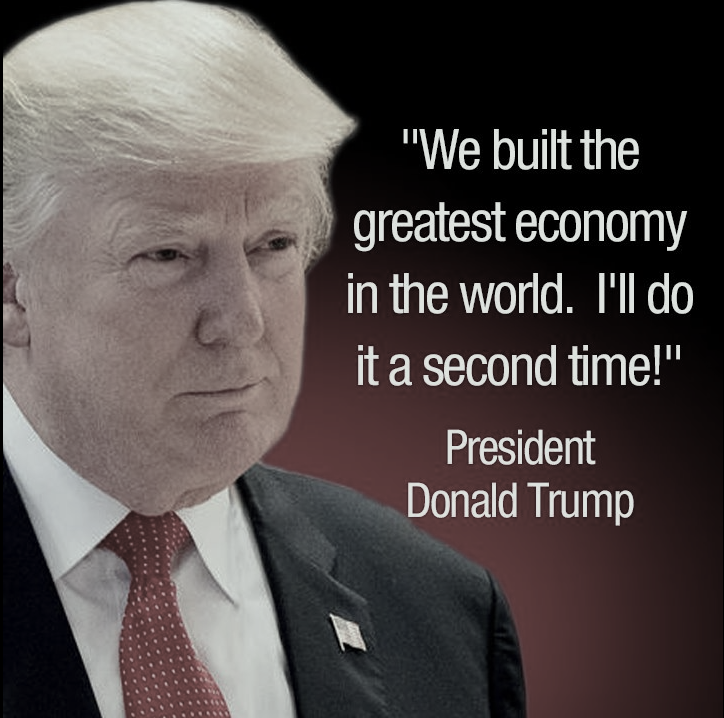
When it comes to the economy, voters believe Trump and the Republicans have done and will do a better job than Biden, Harris, and the Democrats. In a Reuters/Ipsos poll (June 23) voters picked Trump 43% to 37% over Biden as having the better approach for the economy. In a ABC News/Ipsos poll (May 18), voters said they trusted Trump over Biden by a margin of 14 percentage points on the economy and inflation. A recent Gallup poll (May 6) reveals 82% of Democrats and 86% of Republicans have confidence in their respective candidates. Independents, however, tend to favor Trump by a significant margin: 45% have confidence in Trump, while 34% have confidence in Biden. Finally, a March 2024 CBS News poll found 65% of voters rated the economy as good during Trump’s presidency, compared to 38% under Biden.
The Biden Administration’s low approval ratings on the economy and inflation have puzzled economists. The US economy is now very strong, generating the world’s strongest growth post-pandemic of any country. The quarterly gains in gross domestic product (GDP) are consistently above those achieved under Trump. Record numbers of jobs have been created, again far surpassing the number under Trump. Unemployment has consistently remained at low levels. The stock market, moving mostly up and sometimes down, has posted solid gains and reached record highs.
It is true that inflation rates and prices for gas and groceries shot up during Biden’s first 2 years. However, we’ll see shortly that these increases had little or nothing to do with Biden’s actions. Also, the inflation rate has dropped substantially since reaching historic highs in June 2022. As of July 2024, it again came in at 3%, just over the Fed’s preferred target of 2%. Gas prices have also come down. Wage growth is now exceeding the rate of inflation, giving Americans more spending power. Finally, it’s increasingly certain the economy will achieve a historic and difficult “soft landing” where inflation is tamed without driving the country into recession.
The real progress in vanquishing inflation is best shown visually. Below is a 10-year graph showing the inflation rate (red line) and interest rate hikes by the Federal Reserve (blue line). With the Covid-19 pandemic and the ensuing recession in 2020, we see that the Federal Reserve (Fed) dropped interest rates to zero in order to stimulate the economy. As inflation began to climb in early 2021, we see the Fed left interest rates at zero to keep stimulating the economy. By March of 2022, with inflation exceeding 8%, the Fed finally raised interest rates for the first time. It raised them two more times before inflation peaked at 9.1% in June 2022. By the time the Fed adopted its last interest rate hike (July 2023), there were 11 total hikes that raised interest rates from 0.0% to 5.25%. The Fed’s rate has remained at 5.25% for over a year, as inflation dropped rapidly from 9.1% to about 3% in just one year. The inflation rate has mostly stayed within the range of 3% to 3.5% since June of 2023 (13 months and counting). This is almost, but not quite, a return to normal.

These facts aren’t hitting home to most Americans. The graph below, from a May 2024 Pew Research study, shows that only 23% of US adults currently view economic conditions as excellent or good. Along party lines, only 10% of Republicans and 37% of Democrats believe economic conditions are excellent/good.
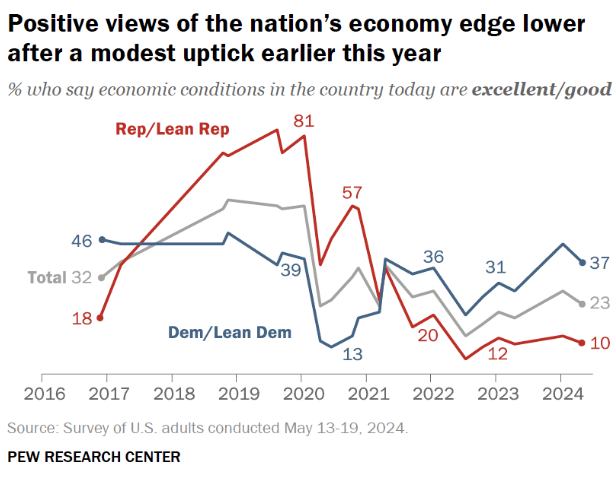
Even more telling, a recent Harris survey for The Guardian (May 22, 2024) found that 56% of Americans believe the economy is currently experiencing a recession. Almost half (49%) believe unemployment is at a 50 year high. Almost three-fourths (72%) believe inflation is increasing. All three of these perceptions are flat wrong. Finally, 58% believe the economy is worsening due to mismanagement by the Biden Administration.
An earlier Harris poll (September 2023) found two-thirds of Americans (65%) believe that the economy is worse than the media makes it out to be rather than better (35%). Two-thirds of respondents (68%) reported it’s difficult to be happy about positive economic news when they feel financially squeezed each month.
What has caused this disconnect, where so many Americans are pessimistic about the economy and Biden’s handling of it?
Curious about this disconnect, I decided to do a deep dive on why Americans are so gloomy about the economy and Biden’s stewardship. I conclude the primary reason is that tens of millions of Americans have been duped by former President Trump and his allies via a sophisticated messaging campaign. Many of the messages are misleading, deceptive, and sometimes outright fabricated. Through these messages Trump falsely takes credit for positive economic developments and dubiously blames the Biden Administration for negative economic conditions. For instance, earlier this year Trump claimed that strong stock market gains under Biden were a “Trump Market” because polls showed him way ahead in presidential race and this was stoking the market. With the recent stock market decline, he suddenly stopped taking credit and now blames Vice President Harris for crashing the market and ruining the economy. He, along with Republicans and the conservative media, have convinced tens of millions of Americans–especially Republicans and independents–that he is very strong on the economy and Biden is a failure.
Aside from the messaging campaign, I found three contributing causes for the pessimism. First, when people struggle with their personal finances they always tend to see the economy as bad and blame the sitting President. Second, the Biden Administration and Democrats have not effectively confronted and rebutted Trump’s messaging campaign. And, third, the media has predominantly focused on the economic hardships suffered by Americans, including their dim views of the economy and Biden’s performance. In essence, the media has fanned the flames of economic pessimism. The media has done a poor job of educating Americans on what actually caused the high inflation, how it is being brought under control by the Fed, and fact-checking Trump’s misleading and false messaging.
In this post I’ll start by laying out the five major components of Trump’s messaging strategy. We’ll explore just how he has been able to hoodwink so many Americans that he is so great on the economy and Biden is such a failure. I’ll then consider the other causes that contribute to pessimism regarding the economy and Biden . Finally, I’ll explain why knowing about Trump’s messaging campaign is so important when it comes to choosing our next President.
Messaging strategy #1. Trump regularly takes credit for favorable economic conditions, even though he did little or nothing to create them; and he blames Biden for negative economic conditions, even though Biden did little or nothing to create these conditions.
Trump extols the fact that inflation was low to nonexistent during his presidency. He also takes credit for low gasoline prices, record low levels of unemployment, strong growth in the gross domestic product (GDP), booming stock market gains, real wage gains, and other positive conditions. He often cites legitimate numbers or percentages to back his claims. One the other hand, Trump maintains the Biden Administration is solely responsible for record high inflation, skyrocketing gas and grocery prices, crushing interest rates, and other negative conditions. Again, he often cites numbers and percentages to back up his claims.
The problem with Trump’s assertions is that they ignore the crucial issue of causation. That is, in deciding whether Trump deserves credit or Biden deserves blame for a condition, shouldn’t there be evidence that they did something to create that condition? If a positive economic condition was already occurring, it’s deceitful for Trump to claim he made it happen. Similarly, just because a negative condition occurs during Biden’s term doesn’t mean he caused it. If there is evidence that the negative condition was caused by factors other than Biden’s actions, isn’t it deceitful for Trump to blame Biden for the condition?
Consequently, it’s necessary to review Trump’s narratives to discern the critical issue of causation. Did Trump create or cause the good economic conditions for which he takes credit? And did Biden cause the negative economic conditions for which he is being blamed? To answer these questions I examined longitudinal data on the economic metrics Trump uses to support his claims. I also considered what other world countries were experiencing regarding these metrics during the same period of time.
Here are my findings for four of the key metrics Trump often uses to make his claims: inflation rates, gas prices, groceries inflation, and real wage growth.
Inflation rates: G-7 countries
Below is a graph of inflation rates for G-7 countries going back to 2000. From 2000 through 2020, we see that inflation rates for these countries generally hovered in the range of 1.5 to 3%. The US inflation rate (gold line) was usually within the pack. We also see that during the first 3 years of Trump’s term (2017-2019), US inflation rates were in the range of 2% to 2.5%; and most of the G-7 countries were enjoying similar low rates. But then, as the world dealt with Covid-19, supply chain shortages, and the February 2022 Russian invasion of the Ukraine, inflation rates jumped dramatically in all G-7 countries. Most rates peaked in mid 2022, and the US was no exception with its peak of 9.1% in June 2022.
Trump blames Biden’s out of control spending for creating the crushing inflation (“highest in 40 years”). This conclusion is suspect because all G-7 countries suffered high inflation during the same period, suggesting there was something else going on other than Biden’s spending. Trump cites and takes credit for his very low inflation numbers, and sometimes even says there was “no inflation.” The data show that all G-7 countries were enjoying low inflation during the time Trump was President. The data also show that all G-7 countries encountered very high inflation in the timeline of 2021 and 2022. Finally, the data show that in the 17 years prior to Trump’s presidency, the US inflation rate was low and in the middle of the pack of the G-7 countries. Thus, Trump didn’t create low inflation; rather, he simply was President during a period when inflation was low.
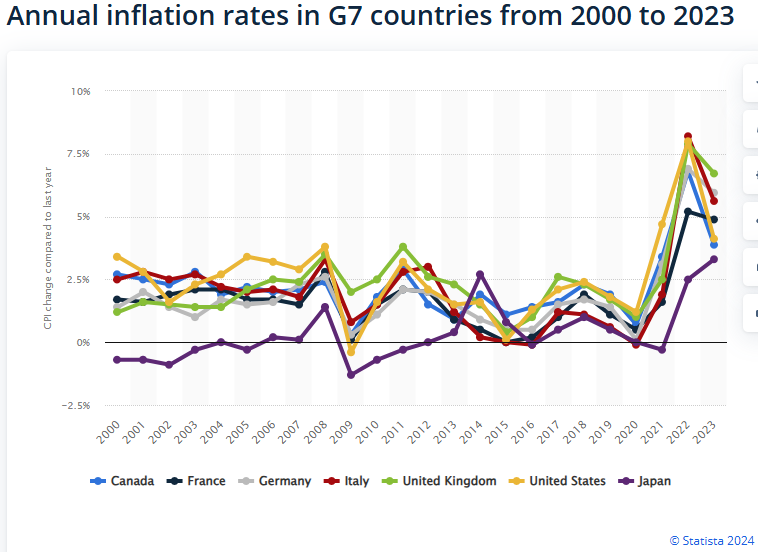
Gas prices: US and Canada
As to gas prices, below is a 10-year Gas Buddy chart on US and Canadian prices per gallon. What jumps out is that gas prices in the two countries tend to rise and fall in tandem, with Canadian gas usually costing $2 to $3 more per gallon. During Trump’s term of office (2017-2020), gas prices stayed consistent with the final years of the Obama Administration. They hovered in the range of $2.25 to $2.90 per gallon. Then, in connection with the Covid-19 pandemic and supply chain issues, gas prices started to jump in early 2021 in both the US and Canada. They spiked further at the time Russia invaded the Ukraine (February 2022), and peaked in June 2022 ($5.01 per gallon in the US and $7.95 in Canada).
Trump cites low gas prices during his tenure and compares them with the $5.00 per gallon or more under Biden. He claims he created energy independence, which allowed for the record low prices. However, gas prices were already low before he came into office. He blames high gas prices on Biden, due to Biden’s crushing inflation and his war against fossil fuels. This blame is unfounded in that the spike in US gas prices in 2021 and 2022 coincided with increasing worldwide inflation as we saw in the previous graph. Supply chain issues, Russia’s invasion of Ukraine, profiteering by American businesses, and high inflation in general drove the increase in gas prices during this time. Trump does not mention that gas prices have gone down considerably since peaking well over two years ago. Nor does he mention that oil production in the US is now at the highest level ever. Nor does he mention the huge and record profits that US oil companies are making.
Thus, Trump did not create low gas prices; he simply presided during a time when gas prices were low. Nor did Biden create high gas prices; the spike in prices was due to the other factors mentioned above.
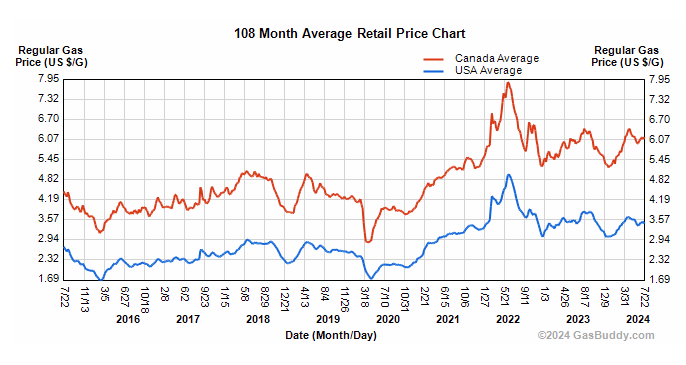
Food inflation: US and other countries
As to food inflation, below is a graph from Trading Economics that compares food inflation in the US, European Union, the UK, and Japan over the period of 2014 to 2024. During the period of 2014 through 2021, food inflation for these countries/regions was modest, with the US (blue line) staying in the middle of the pack. During Trump’s term (2017-2020) US food inflation continued to be in the middle of a tight pack. By 2022, however, food inflation skyrocketed in all 4 countries/areas. Food inflation in the US didn’t peak as high as the European Union and UK, and it came down sooner than the other countries/areas.
Trump takes credit for the low cost of groceries during his term. He cites how much more groceries now cost compared to when he was in office. He blames Biden for the high cost of groceries. He does not mention that US food inflation peaked in June 2022, and that inflation rates have since been declining for over two years. Nor does he mention the record profits the US food companies and grocery chains generated during this time. The data show that food inflation was low in other countries/areas of the world during Trump’s term. Food inflation was also low in the many years prior to when Trump took office. Food inflation jumped and peaked in these same areas of the world during 2022 and 2023. Thus, Trump did not create low food costs. He simply presided during a time when food costs were low in the US and internationally. Nor did Biden create high food costs; instead, the inflation is due to the other factors identified above.
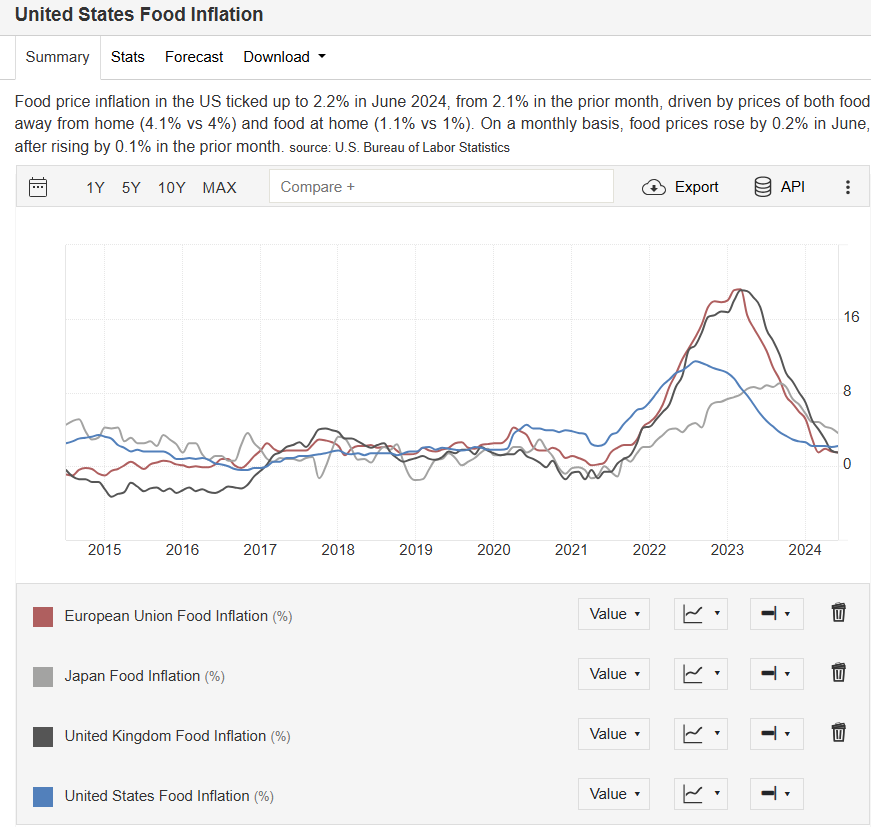
Real wage growth
The chart below from Axios compares how average hourly wages (blue line) are changing compared with inflation (gold line). When wages are increasing more than the rate of inflation (blue line is above gold line) this is good for workers because they gain more spending power. When inflation is greater than wage growth (gold line is above the blue line) this is bad for workers because they are actually losing spending power.
As we see from the chart, during Trump’s term wage growth stayed modestly above inflation for the first 2 years. Then, in 2019 and 2020, wage growth accelerated above inflation, much like it did in 2015 and 2016, under Obama. Trump immediately took credit. Then, when the pandemic hit (early 2020), wage growth temporarily skyrocketed that April. This sharp increase in wages occurred because millions of relatively low-paid workers lost their jobs, while relatively high-paid workers remained employed. The shift in the composition of those employed caused the average wage to rise. Again, Trump took the credit. While he continues to cite the numbers as proof that he created record wage growth, the growth occurred for different reasons.
Soon after Biden assumed the presidency, wage growth began to sharply lag inflation in April of 2021. Many countries in the world experienced the same problem, and the worldwide average real wage growth fell significantly for the first time in 2022. As the inflation rate continued to climb (peaking at 9.1% in June 2022) wage growth remained below inflation for almost two years. Then, as we can see, wage growth started to overtake inflation in February of 2023. This favorable condition has continued for 17 months and counting.
Trump blames Biden for causing the loss in real wages, saying it was due to the crushing inflation Biden created. Trump does not mention that other countries in the world were experiencing this problem during this time. Nor does he mention that there has been real wage growth for Americans for 17 months and counting. Thus, Trump did not create real wage growth significantly higher than the wage growth during Obama’s term. Nor is Biden responsible for the decline in wage growth that occurred in 2021 and 2022. The decline was due to other factors mentioned above, and real wage growth has been above the inflation rate since early 2023.
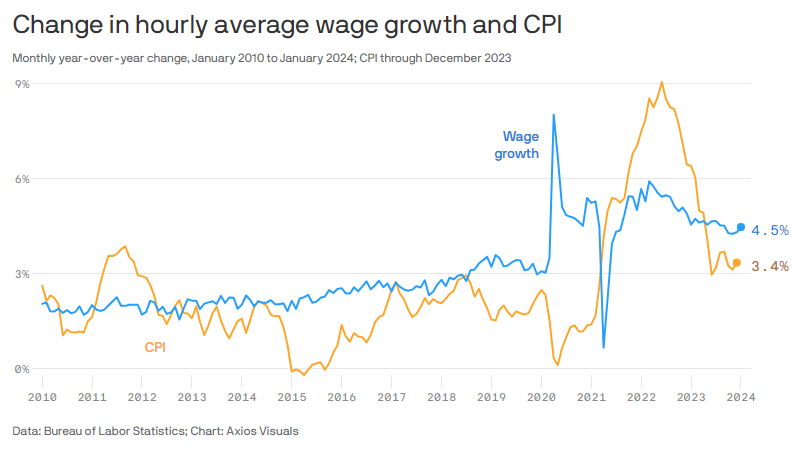
From these four examples we can clearly see that Trump has taken credit for economic conditions that were already favorable before and during the time he was in office. His results mostly continued the numbers of the prior administration (Obama); and these results were in line with what other countries were enjoying during the same period of time. On the other hand, we see clear evidence that the Covid-19 pandemic, the worldwide recession, supply chain issues, and Russia’s invasion of the Ukraine had a huge effect on rates of inflation, gas prices and food inflation both in the US and other countries. Biden certainly did not cause high inflation and prices in all these other countries. Nor did US inflation, gas prices, and food inflation shoot past the rates of other countries.
While it’s certainly arguable that Biden’s policies and actions had some effect on these factors, Trump is deceiving Americans when he declares Biden is to blame. He is also deceiving Americans when he takes credit for favorable conditions that he did little or nothing to create. Moreover, the argument that he and the Republicans are better on the economy is called into question.
Messaging strategy #2. Trump seizes on the fact that millions of Americans are hurting economically by blaming the Biden Administration for their struggles, regardless of whether his Administration caused or can do anything about the struggles.
Hundreds of millions of Americans are struggling financially. A majority are living paycheck to paycheck. They suffer sticker shock whenever they buy gas, groceries, or pay rent or utility bills. They are doing without. They are incurring increasing credit card debt. Interest rates are so high they can’t purchase a home or a car. Because so many millions of Americans are actually hurting, Trump has a huge and receptive audience.
Most Americans probably do not understand that the President has little to no control over inflation, gas prices, grocery prices, or interest rates. The Federal Reserve (Fed) is largely in charge of addressing inflation. It is an independent body that is not controlled by the President and strives to keep politics out of its decisions. One of the Fed’s key tools is its control over interest rates. Also, the private sector, and not the President, controls prices on virtually everything we buy, including gas, groceries, cars, and consumer goods.
If we look at the economy compared with where it was in June of 2022, with inflation at 9.1%, conditions have greatly improved. Through a series of interest rate hikes the Fed has avoided a recession and brought down inflation to 3% (the (PCE inflation) is down to 2.5%). These actions are the “tough medicine” necessary to bring the economy and inflation back into line. In fact, economists are increasingly optimistic that a historic “soft landing” will be achieved, a feat only once accomplished. A sizable percentage of economists recommended that the Fed begin lowering rates at its July meeting, but it declined to do so. Many think this makes it all but inevitable the Fed will adopt a 0.25% or 0.5% cut in September.
But instead of acknowledging the role of the Fed and the private sector, Trump has been telling hundreds of millions of Americans that Biden is responsible for the high gas prices, grocery prices, and the “crushing” interest rates that push them deeper into credit card debt and make it impossible to buy a car or a home. He reminds them of how low food, gas, and interest rates were when he was President. He doesn’t tell them that it is the Fed, and not Biden, who controls interest rates. He doesn’t tell them how close the country is to the ideal “soft landing.” And he doesn’t tell them that the high prices they’re paying are enabling record profits by many American businesses. Instead, he promises to undo the economic disasters inflicted by Biden when he returns to the presidency. It’s no wonder that so many Americans have been misled to believe that Biden is responsible. They think he has the power, but not the acumen or the will, to relieve their suffering.
Messaging strategy #3. Trump overstates positive economic developments during his term and understates or ignores positive developments during the Biden Administration.
Trump boasts about the record number of jobs created during his Administration. He also claims the gross domestic product (GDP) grew at record rates, and he achieved record low unemployment rates. On the other hand, he minimizes or understates economic gains made by the Biden Administration. This messaging strategy is different than the first one in that Trump is exaggerating and minimizing as opposed to ignoring causation when taking credit and assigning blame. Let’s explore this messaging with a few charts.
Annual job growth
Below I display annual job growth (new jobs) going back to 2015. As you can see, for Trump’s first 3 years (2017, 2018, and 2019), around 2 million jobs per year were added. As to 2021 and beyond, it’s clear that job growth far exceeds these rates, with 4 million in 2021, 6 million in 2022, and just over 3.5 million in 2023. Further, the number of jobs created in 2015 and 2016 were greater than during Trump’s years. Thus, Trump misleads Americans when he claims record job growth. He overstates his record. He also attempts to negate the record of the Biden Administration by saying its job gains were just adding back job losses that occurred during the pandemic. Ironically, Trump claimed full credit for the massive monthly increases in jobs in the latter part of 2020.

Growth in gross domestic product (GDP)
As to growth in GDP, below is a chart with data from the US Bureau of Economic Analysis. While GDP growth was healthy during Trump’s first 3 years, it wasn’t in excess of that achieved during the period of 2004-2008. And, more important, the GDP growth during the period of 2021 through 2024 far exceeds the growth during Trump’s first 3 years. Thus, Trump misleads Americans when he claims record GDP growth. GDP growth during both the Obama and Biden Administrations exceeded Trump’s record.
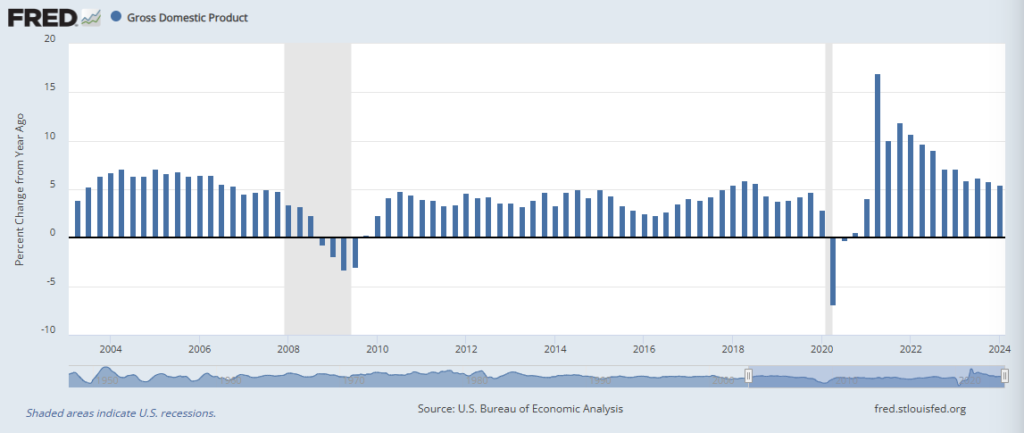
Unemployment rate
Finally, let’s look at the unemployment rate, using a chart with data from the US Bureau of Labor Statistics. It is true that unemployment levels reached record low levels by late 2019. But when we look at the big picture, it’s clear that unemployment levels were gradually dropping after reaching a high of about 10% in 2010. This steady drop mostly occurred during the Obama Administration. During Trump’s first 3 years, the unemployment rate dropped from 4.7% to a 50-year low of 3.5%. As you can see, the rate of the drop was consistent with rate of drop since 2010. Had the unemployment rate not fallen from 10% to 4.7% in the seven years prior to 2017, it would have been impossible to reach a low of 3.5% when Trump was in office. With the pandemic, unemployment shot up to 15%. And then, during the Biden Administration, the unemployment rate has been at near record lows for almost three years, after reaching a 53-year low in 2023.
Trump is misleading Americans by claiming that he created record low unemployment rates. In truth, unemployment rates are far more affected by economic conditions such as recessions (see chart for effect of recession of 2008-09) and the 2020 pandemic. Otherwise, rates tend to gradually rise and fall in accordance with the economic cycle.
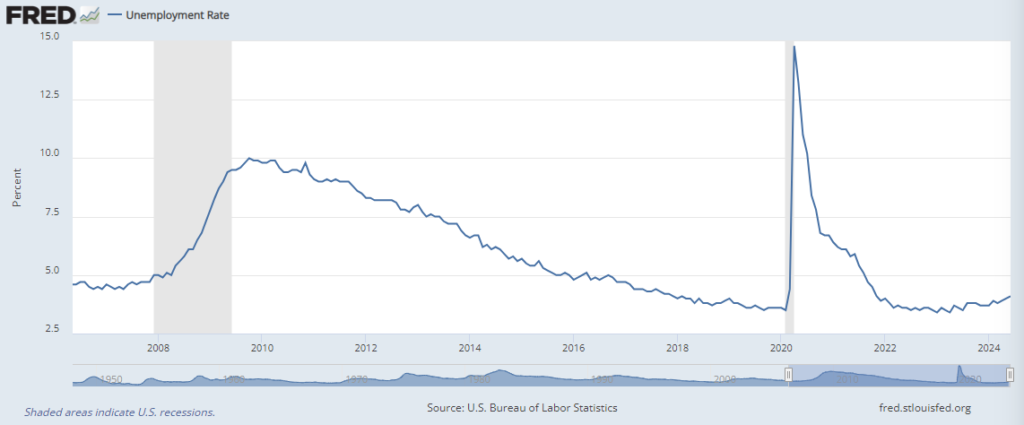
Stock market performance
Trump has been especially aggressive in overstating his record in creating a booming stock market and characterizing the terrible results under Biden. His messages are sometimes outright wrong, unfounded, overblown, self-aggrandizing, and unjustifiably diminishing of Biden. A recent article recounts several of these statements.
- In campaigning for President in 2020, Trump said, “If he’s [Biden] elected , the stock market will crash.” It didn’t.
- A month after he was out of office in February 2021, he claimed credit for the strong stock market on account of his prior efforts to restart the economy.
- In 2022 and 2023, when the stock markets temporarily turned down, he said, “We are a failing nation. Does anybody have a 401(k)? Raise your hand if you’re happy with it. I’ll tell you this, they were happy when I was running this country.” He compared the downturn to the Great Depression stock market crash in 1929.
- In January 2024, in connection with his primary wins in Iowa and New Hampshire, he claimed that the recent market highs were due to his wins and the increasing chances of a second Trump Administration. On Truth Social (January 29) he said in all caps, “THIS IS THE TRUMP STOCK MARKET BECAUSE MY POLLS AGAINST BIDEN ARE SO GOOD THAT INVESTORS ARE PROJECTING THAT I WILL WIN, AND THAT WILL DRIVE THE MARKET UP.”
- By February 2024, Trump had gone back to predicting a crash if he doesn’t win. He said, “We are a nation whose stock market’s continued success is contingent upon MAGA winning the next election. If we don’t win the next election, the stock market will crash just like it did in 1929.”
Just recently, when the stock market dropped sharply because of a poor jobs report, the Fed’s decision not to lower interest rates, and a recent uptick in unemployment, Trump pivoted to blaming Vice President Harris. He called it a “Kamala Crash” and said, “STOCK MARKETS CRASHING. I TOLD YOU SO!!! KAMALA DOESN’T HAVE A CLUE. BIDEN IS SOUND ASLEEP. ALL CAUSED BY INEPT U.S. LEADERSHIP!” Forbes, and even Fox News, called out Trump’s trying to have it both ways.
In reality, the various stock market indexes have performed well, both during the Trump and Biden Administrations. In fact, as you can see from the graph below, they have doubled in value since 2012. More to the point, however, Presidents have little influence over the changing values. Trump deceives Americans when he claims direct responsibility for gains, blames the Biden Administration for losses, and maintains the market will skyrocket if he is elected and crash if Harris wins.

From these four examples we see that Trump consistently overstates his economic achievements and consistently denigrates or ignores those occurring during the Biden Administration. Such statements mislead and deceive Americans. But Trump also often pushes further to peddle outright lies and baseless statements. We’ll explore this final aspect of his multi-part messaging campaign in the next section.
Messaging strategy #4. Trump employs the “firehose of falsehood” propaganda technique to get Americans to believe either outright lies or totally unsupported statements about his economic successes and Biden’s failures.
The “firehose of falsehood” is a Russian propaganda technique that involves communicating messages rapidly, repetitively, and continuously over multiple channels without regard to truth or consistency. Originally explored in a Rand report, the strategy enables a propagandist to overwhelm public opinion by producing a never-ending stream of misinformation and falsehoods repeated in the news, social media, political campaigns, and other channels. Rand found that the lies didn’t have to be believable. Even outright falsehoods, repeated widely and frequently enough, can be effective in causing people to believe them.
Here are some examples of outright lies, falsehoods, and totally unsupported statements made by Trump:
“Joe Biden has been a disaster for the economy. Between his massive tax hikes, his anti-energy crusade, and his trillions of dollars in wasteful spending, Biden caused the highest inflation in almost half a century. As a result, interest rates soared to crushing levels. And now we’re seeing bank failures that nobody believed even possible just two years ago. Joe Biden is leading us toward a Great Depression.”
Trump, from the Agenda 47 section on his 2024 campaign website
“During my presidency, we had “the best economy in the history of our country, in the history of the world … We had no inflation, soaring incomes.”
Trump, from his acceptance speech at the Republican National Convention
“Just a few years ago, I handed Joe Biden the fastest economic recovery in recorded history. But as soon as he came into office, he quickly blew it all up. It was a shame. So sad to watch. I knew what was happening. I could see it and so could others. Biden and the radical Democrat Congress single-handedly created the highest inflation in decades. They spent trillions of dollars waging war on American energy and pursued the Socialist joke known as the Green New Deal, an absolute disaster for our country. Now, the inflation and high interest rates that Joe Biden caused have resulted in the Biden Banking Crisis, a disaster of historic proportions.”
Trump, from the Agenda 47 section of his 2024 campaign website
“I built the greatest economy in the history of the world. In fact, I did it twice when you think about it, and now we will have to do it again.”
Trump, from the Agenda 47 section of his 2024 campaign website.
“If you took the 10 worst presidents in the history of the United States – think of it, the 10 worst – added them up, they will not have done the damage that Biden has done.”
Trump, from his acceptance speech at the Republican National Convention
If you follow Trump in his campaign speeches, social media posts, and other public comments you’ll see that he continuously repeats the statements above, often with slight variations. You’ll also see these statements repeated on Fox News and other conservative media outlets. Republican officeholders also join in on promulgating the falsehoods and baseless statements.
What distinguishes this aspect of the multi-part messaging strategy is that Trump knows and doesn’t care that such statements are false or unprovable. It’s okay to repeat a lie or unfounded statement because it has been proven that many people will come to believe it as true.
In addition, promulgating repeated lies and unfounded statements makes it very difficult for the media to do its job and for voters to find the truth. This “fog of disinformation” produces just enough distrust to ensure that the public will give up on knowing the truth. If you saturate the system with misinformation you can overwhelm the ability of the media and the people to find or know the truth. Steve Bannon infamously described this strategy as, “flooding the zone with shit.” The objective is to fatigue and frustrate the media and voters in finding the truth. With weariness and fatigue, more and more people abandon the idea that the truth is knowable.
Finally, the antidote to a firehose of falsehood, which is fact-checking and debunking, has its downsides. Research shows that the act of debunking serves to amplify the lies. Thus, even if you reject an argument, merely repeating it locks the thought in people’s minds. Debunking remains useful of course, but there’s a cost to dignifying a lie in the first place.
The firehose of falsehood is thus a great “hole card.” If Trump can’t get voters to buy his views with the other messaging strategies, he always has the option of endlessly repeating an outright lie or unfounded statement.
The “firehose of falsehood” strategy is especially effective with Republican and Republican-leaning independent voters. Research on “confirmation bias” says that we seek out and remember information that confirms what we believe, and we ignore or forget information that disputes it. Also, research on “motivated ignorance” says that we often willfully blind ourselves to facts. It’s choosing not to know. In many cases and for many people, knowing the truth is simply too costly, too psychologically painful, and too threatening to their core identity. The firehose of falsehood messaging gives many Americans the “truth” they choose to cling to. Thus, when presented with compelling evidence or arguments against a position they hold, they can reject this information. Doing so fends off the distress of realizing they’ve been lying to themselves and others.
While confirmation bias and motivated ignorance may enable us to avoid psychological distress, it doesn’t change the underlying problem. The firehose of falsehood propaganda technique has misled and deceived millions of Americans into believing something that isn’t true. Trump and the Republicans may not be better on the economy, and the Biden Administration may not such a failure; but millions will never admit it.
Messaging strategy #5. Trump criticizes and condemns the media for its biased and “fake news” coverage in support of liberals, and for questioning (fact-checking) his economic messaging.
The final component of Trump’s messaging strategy is to rebuke any reporting that questions his claims or provides positive coverage regarding the economy and the Biden Administration’s efforts. Trump has long criticized the mainstream media as being “fake news.” He says the “lamestream media” is biased, a tool of the liberal Democrats, and is “stupid and corrupt.” He has also threatened retribution: “I say up front, openly, and proudly, that when I WIN the Presidency of the United States, they and others of the LameStream Media will be thoroughly scrutinized for their knowingly dishonest and corrupt coverage of people, things, and events.”
This strategy serves to pressure the media to bend over backwards to be fair to Trump. For instance, instead of a news story providing an analysis and discussion of how Trump lied or misinformed with a certain statement, the story will show or report Trump making the statement (lie or misinformation) and then note that the statement was made without evidence or support.
The strategy also serves to encourage Americans to discount and distrust the mainstream media. Trump’s message is that the mainstream media outlets are the ones doing the lying and misinforming. He’s the one who’s telling Americans the truth, and the media is dishonest, corrupt, and biased against him.
But what about the conventional wisdom that voters tend to see a bad economy and blame the sitting President when they struggle financially; isn’t this the real reason for their pessimism regarding the economy and Biden?
In my view, this is not an either or proposition. Certainly, many voters are pessimistic about the economy and Biden’s performance because they’re having such difficulty with their finances. But this does not preclude the fact that many voters are down on the economy and Biden’s performance because they have been hoodwinked by a sophisticated messaging campaign. In fact, the very high level of pessimism may be the product of synergy in these two causes.
Think about it. What if voters were informed and convinced that many of the positive economic conditions Trump take credit for were already occurring in the US and other countries during his presidency? What if voters were informed and convinced that Biden was not the main culprit for high inflation, high gas prices, high interest rates and other negative conditions that Trump blames him for? What if voters knew that the Fed is in charge of bringing down the rate of inflation and setting interest rates? What if they knew that the process takes time, and the economy is coming in for a soft landing? What if we cancelled out all of Trump’s claims for credit, blaming of Biden, and lies unfounded statements regarding the economy? Would Americans still be so pessimistic about the economy and Biden?
When we look recent poll results, it’s abundantly clear that millions of Americans have been hoodwinked by Trump’s messaging campaign. As noted earlier, 56% of Americans falsely believe the economy is currently experiencing a recession. Almost half (49%) falsely believe unemployment is at a 50 year high. Almost three-fourths (72%) falsely believe inflation is increasing. 58% believe the economy is worsening due to mismanagement by the Biden Administration. And, 65% believe the economy is worse than the media makes it out to be.
While my analysis concludes that Trump’s messaging campaign is the primary cause of pessimism regarding the economy and Biden’s performance, I certainly acknowledge other robust causes. It’s clear that the personal financial struggles of nearly half of Americans have contributed to this pessimism. In addition, Trump’s messaging campaign does not exist in a vacuum. The Biden Administration also has a messaging campaign; and this campaign has been ineffective in confronting and rebutting Trump’s false and misleading messaging. Finally, the media has contributed to the pessimism. It has concentrated on the personal struggles and hardships faced by Americans and Biden’s poor performance in polling regarding the economy. Should the media be doing more to confront and rebut Trump’s misleading and erroneous statements? And should it be doing more to inform the public about the role of the Fed, the limited powers of the President, and the solid progress being made in economic recovery?
Let’s briefly explore the Biden Administration’s messaging campaign and the shortcomings of media coverage before drawing final conclusions.
The Biden Administration has been hard pressed to develop a messaging campaign that informs voters of the strong economy and touts its successes at the same time most Americans are struggling financially and listening to Trump and the media reinforce their suffering.
The Biden Administration has certainly tried. It touts the great jobs reports that have been occurring every month, the steady decline in inflation rates, the increase in real wages, the strong growth in GDP, and America’s standing as the world’s greatest economy. It pushes “Bidenomics” to explain how the economy was growing “from the middle out, and the bottom up, not the top down.” In its exuberance, the messaging campaign has occasionally stepped over the line to promulgate its own lies and misleading statements.
This information has not been very compelling for the majority of Americans who are still suffering financially. When people are living paycheck to paycheck, making daily sacrifices, confronting interest rates that prevent them from buying a house or a car, and feeling stressed about their finances, they aren’t “feeling” this great economy. In fact, when they daily see the media offering stories about the hardships faced by Americans and how expensive everything is, they can’t help but be influenced. Add in that Trump’s narratives have undoubtedly reached them time and again, and it’s no wonder Americans don’t feel buoyed up by “Bidenomics” and the positive economic developments.
The challenge is to develop a messaging campaign that provides hope and addresses the suffering of the huge number of Americans still struggling financially. Telling them that high inflation was not your fault seems like an excuse and doesn’t solve their problem. Nor does telling Americans you have no control or gas or grocery prices. Nor does telling them that you don’t control the interest rates that put them into credit card debt and make it impossible to buy a car or a home. You could inform the public about the Fed and its control of interest rates, and you can tout the steady progress being made. But this entails admitting that you have limited power to fix the root causes of their suffering. The same is true of corporate greed. You can inform Americans of all these facts, but you have little or no power to remedy the situation. And, Americans continue to suffer.
Confronting and rebutting Trump’s lies and falsehoods adds a layer of complication. First, there are so many false narratives that they can’t all be addressed. Second, in challenging the lies, you repeat them and give them credence. And, third, proving to voters that Trump has misled them doesn’t solve their problem. They are still suffering economically.
The Biden Administration’s ineffective messaging campaign definitely contributes to pessimism regarding the economy and low regard for Biden’s performance. Given the circumstances however, the messaging challenge is daunting. I did not find much that the Biden Administration could have done differently to move the needle on the pessimism. Certainly, the lies and misleading statements, which are comparatively few in number, could be eliminated. Also, there could be more recognition and empathy for the continued suffering of Americans. The Administration should be telling Americans it recognizes their suffering. It should acknowledge that they don’t yet feel progress in spite of the positive economic developments. Also, the public could be better informed of efforts by the Fed, including the likelihood of a “soft landing” and interest rate reductions in the near term.
The effort to confront and challenge Trump’s lies and misleading statements could be improved by tying this effort to the upcoming election. Rather than challenging or rebutting lies and misleading statements on a piecemeal basis, more focus should be placed on exposing Trump’s messaging campaign. If voters understood how Trump is falsely taking credit for conditions he did not create, and how he is falsely blaming the Biden Administration for failures it did not create, this could influence their votes for President.
While the media has contributed to pessimism regarding the economy and low regard for Biden’s efforts, it has attempted to debunk and fact check Trump’s assertions, and it has reported on improvements in the economy.
In reviewing hundreds of stories regarding the economy, I validated the tendency of the media to focus on the negative. A story in The Atlantic offered this example (quoted below) when it comes to pessimism about the economy:
The jobs report released last October was a thing of beauty. Over the previous month, the U.S. economy had added 336,000 jobs. It was one of the largest gains of the year and nearly double the amount that most analysts had expected—the kind of numbers that traditionally might occasion some celebratory champagne-popping. Here’s how the press covered it: “Jobs Gains Surge, Troubling News for the Federal Reserve,” read a New York Times headline. “Don’t Get Too Comfortable With a Good Job Market,” warned The Wall Street Journal. “September Jobs Report May Be Last Good One Before Sharp Slowdown,” according to Bloomberg.
The Atlantic, Is Economic Pessimism the Media’s Fault? January 12, 2024
The media, after all, is out to make money by attracting and building an audience. Increases in gasoline and grocery prices can be headline news, but decreases are seldom reported in the same manner. Economists predicting an imminent recession get far more attention and coverage from journalists than those who are circumspect. A social media post offering misleading anecdotal evidence to prove out of control inflation can go viral; but a story presenting detailed evidence of gradually improving conditions is far less likely to be shared.
Closely associated with its reporting on the economy, the media has coupled these stories with reporting on polling results regarding Biden’s performance. Again, these are interesting stories because they tie to the 2024 election. The vast majority of print, television, and video stories I reviewed focused on the disconnect: Why is it that so many American’s are pessimistic about the economy when it is doing so well on so many fronts? The media doesn’t say that Biden had done a bad job on the economy (except of course Fox News and other conservative outlets). Rather, it reports on how people are suffering and then pivots immediately to the the latest poll numbers showing Biden’s low marks on the economy. Many media accounts also fault Biden for not effectively informing the public about the progress.
In my review of media accounts I found many, many efforts to debunk and fact check Trump’s assertions about his great successes and Biden’s terrible performance. They are out there, and I regularly cite them in my posts. In addition, I found many, many stories reporting on successes, including monthly job reports, drops in the inflation rate, growth in real wages, and other positive developments. But again, the focus usually pivots to the disconnect: why are Biden’s ratings so low when the key economic indicators are doing so well?
On the other hand, I found far fewer media accounts regarding the Federal Reserve, its role in controlling inflation and setting interest rates, and the steady progress being made in reducing inflation. Perhaps descending into these details is seen as too much “in the weeds.” And such stories certainly don’t meet the “if it bleeds it leads” threshold. Surely, however, it’s newsworthy for struggling Americans to know that the Fed is finally poised to lower interest rates. Surely, it’s important for Americans to know there’s an end in sight for the hardships they’ve been suffering. Surely it’s newsworthy that the American economy is about to come in for a historic “soft landing.”
Conclusion: In making their choice for President, voters need to know that Trump has hoodwinked millions of Americans into falsely believing that he created economic successes, and that the Biden Administration is responsible for economic failures.
The economy and inflation is probably the most critical issue for most Americans in the upcoming election. Voter perception is the Trump and the Republicans have done a better job on the economy than Biden, Harris and the Democrats.
However, when we look at the evidence, we see that many of the positive economic conditions that Trump takes credit for were already in place, both in the US and in other countries. We also see that most of the failures he blames the Biden Administration for were caused by other factors that were worldwide in nature, such as inflation, supply chain problem, Russia’s invasion of the Ukraine, and corporate profiteering. He blames Biden for actions of the Fed, over which the President has no control.
When we dig deeper, we see that Trump and his allies have applied a sophisticated messaging campaign to hoodwink voters on the economy. He, of course, is free to do this. But voters should know about this messaging campaign in deciding their choice for President. When Trump’s messaging is subjected to scrutiny and exposed, it should prompt Americans to reconsider who is better on the economy. Also, voters can decide how they feel about being hoodwinked. And, perhaps most important, voters can decide the kind of President they want in the future.
Should Trump win, the hoodwinking will continue. I predict he will immediately claim credit for creating, yet again, the world’s strongest economy. He will take credit for lowering interest rates that the Fed, after two plus years of combating inflation, will probably start doing in September. He will take credit for taming inflation, which is already near the Fed’s goal of 2%. As the Fed lowers interest rates and makes it easier for Americans to manage credit card debt, and purchase homes and cars, Trump will say he made all this possible. And, finally, should any economic indicators turn south, I predict Trump will blame the Democrats.
The reality of the situation is that the President has very little control over the economy, inflation rates, interest rates, jobs, wages, and other economic conditions. Wars, recessions, pandemics, worldwide conditions, and private sector actions have much more influence, as does the Federal Reserve. Many times we have to simply hunker down as Americans and weather the storm. Going forward, do we want a President who will level with us regarding the long and hard work of improving economic conditions? Or do we want a President who falsely blames others for those conditions and who unfailingly takes credit for positive conditions he did not create?
Leave a Reply